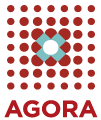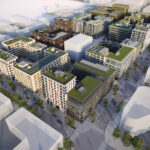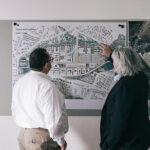In this respect, Belval is a unique laboratory where, day after day, a quarter is being built for everyone. The urban planner Henri Bava, founder of Agence TER, a long-time partner of AGORA in Belval tells us about this wonderful adventure.
What tools does the urban planner have today to create public spaces that are good for social life?
Henri Bava: We have to create dialogue between complex urban dynamics: striking a balance between population density and flow of movement; opening up spaces while ensuring that the diversity of uses is observed; or else working towards a flow of movement in the city that is both continuous and has many forms. It is by harmonising all these concepts, thanks to landscape design, that we can make public space a destination for all.

In concrete terms, how are these grand urban principles transcribed in Belval?
Firstly, it should be noted that in Belval, AGORA wanted the public spaces to be almost equivalent in size to the built-up area, which is already very striking.

One of the major embodiments of the vision described above is, of course, the Belval Sud Park. This is a public space of 10 whole hectares…!

Its function is twofold: to welcome everyone but also to join up the different quarters. A vast open space, visually and spatially connecting Belval Sud, the Belval High School, the Square Mile Quarter and Belval Nord.
As you say, public space is a question of use. How do you balance the variety of uses without negating the possibility of a common social life?
Indeed, it’s a challenge: to respond to the multiple demands of users, in all their diversity, without compartmentalising communities. The Belval Sud park is a good illustration of this requirement, it’s the place where everything is possible!

Playing or practising sports, relaxing, settling down to read, meeting or just moving about: uses vary with the time of day and what everyone needs, all in a setting conducive to interaction. We wanted to avoid isolating high school students from each other, children playing with each other, sportsmen and women from each other etc. So the different spaces are open and porous so that there is contact and the park is a single collective resource.
The public space is also an area of flow of movement. How is this dimension expressed in Belval?
The master plan led by AGORA places great emphasis on the concept of flow of movement.
The main idea is that of continuity: our aim is to ensure that the quarters are porous and in dialogue, that nature and the built-up area are harmoniously enmeshed.

This is done by means of promenades, real urban links. The Wassertreppe is a perfect example: this long green, pedestrian and cycle path runs from Belval Sud, along Belval Nord and the Park, then the Square Mile Quarter to finally reach the Plateau St Esprit.

In this example, water plays an important part…
Absolutely. It is very present on the Wassertreppe. Here water not only symbolises flow, it also uses it: it traces a path for humans who, by following it, cross spaces and become integrated into the landscape.

Does the pandemic have an impact on what is expected of public space today?
Yes, totally. As urban planners, we can see that needs have changed with the health crisis. People have been scarred, particularly by the lockdowns. Today they want a more spacious and airy city, where people are not on top of each other and where they can move around without brushing up against each other.

A very specific example: the size of the paths. We are asked to make them wider, roomier, so that physical distance is observed, among other things. Another example: the exploding demand for cycle paths. Cycling has indeed been one of the big winners of the crisis in terms of mobility.

This is a good thing for Belval: the site has everything it needs to make these post-pandemic public spaces a success. In terms of quality of social life, this is very promising for the future.
Interviews with AGORA employees, partners and experts: with the series “Urban challenges”, discover the values defended and practised by AGORA.
Find all the articles in this series by clicking on the tag below.






